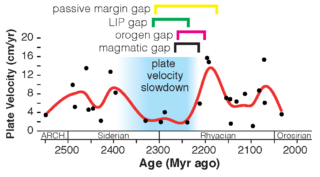Earth’s mid-life crisis
New research backs ‘lull’ in the geologic record

Published in Nature Geoscience, recent research backs claims that the Earth experienced a ‘geological lull’ in its development around 2.3 to 2.2 billion years ago. This work is likely to re-ignite the debate over the Earth’s development, with scientists divided over what geologic processes occurred during the Palaeoproterozoic gelogic era. The research findings point to a near complete shutdown of continental magmatism during this period and has profoundly shaped the geologic record as we know it today.
Dr Spencer’s research shows a bona fide gap in the Palaeoproterozoic geologic record, with not only a slowing down of the number of volcanoes erupting during this time, but also a slow-down in sedimentation and a noticeable lull in tectonic plate movement.
The early Paleoproterozoic was a significant time in Earth history. Oxygenation of the atmosphere began and there was the first global glaciation event, but this was also a period where other geologic processes effectively shut down. It’s almost as if the Earth experienced a mid-life crisis.
The research involved compiling massive amounts of existing geological data as well as examination of rocks collected in Western Australia’s Stirling Ranges, China, Northern Canada and Southern Africa. As more rocks and data were collected, it became clearer that there is very little preserved record for this period.
This ‘dormant’ period lasted around 100 million years and is believed to signal a shift in the style of tectonism, from ‘ancient-style’ tectonics to those more akin to the present day. Earth’s geology started to ‘wake-up’ again around 2.2 to 2.0 billion years ago with an increase in volcanic activity and a shift in the composition of the continental crust.
These findings could provide greater insight into our understanding of the world’s natural resources and where they exist. Continued research into this time period is necessary to better determine how the earth’s geological processes were impacted.
The full research paper has been published in Nature Geoscience and can be found online here.
Contact person: Christopher Spencer, Earth Dynamics Research Group, Curtin University.
Relevant publication:
Christopher J. Spencer, J. Brendan Murphy, Christopher L. Kirkland, Yebo Liu and Ross N. Mitchell, A Palaeoproterozoic tectono-magmatic lull as a potential trigger for the supercontinent cycle. Nature Geoscience, Volume 11, pages 97-101 (2018).; https://doi.org/10.1038/s41561-017-0051-y.
Read the Curtin University Media Release:
Related articles:
